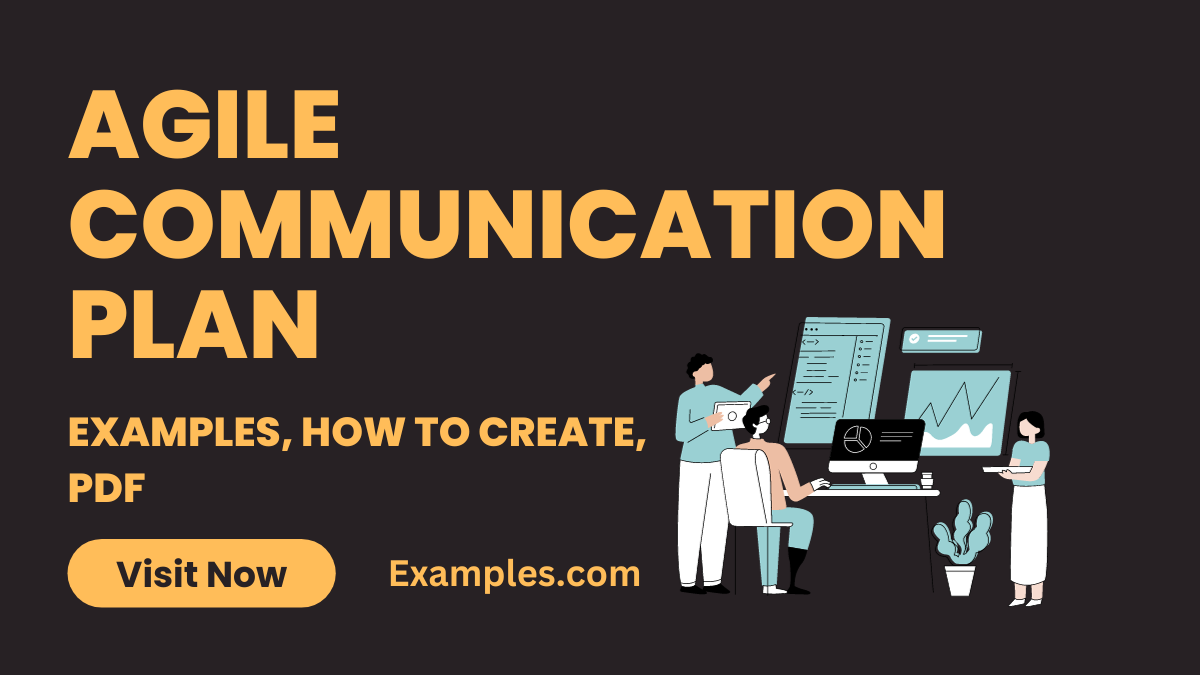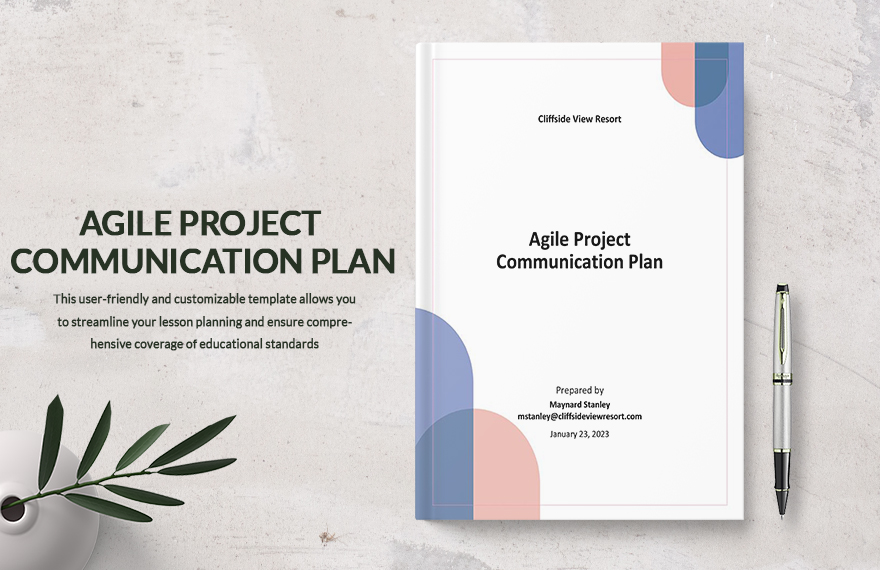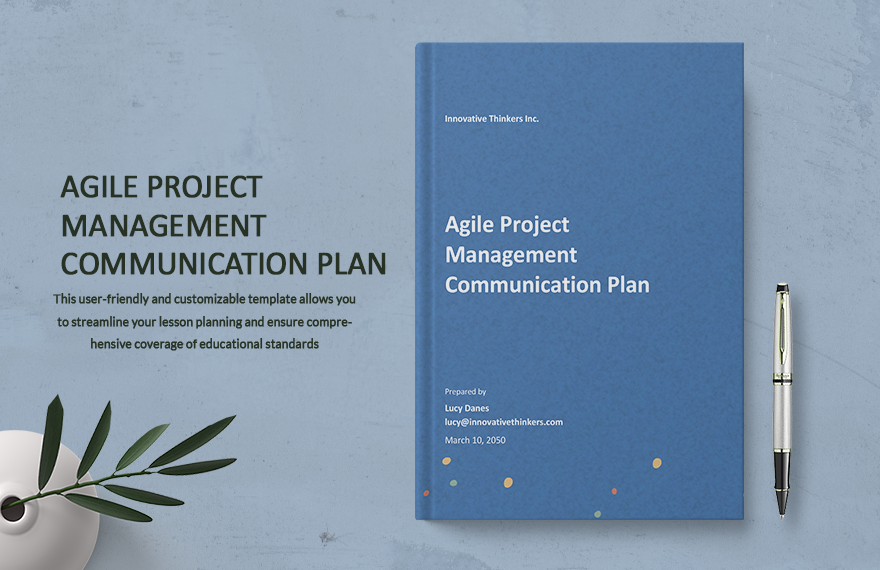7+ Agile Communication Plan Examples
Explore the realm of Agile Communication Plans with our comprehensive guide. Delve into a world where fluid dialogue and adaptability reign supreme. We’ll unveil practical Communication Examples to illustrate the dynamic nature of agile methodologies in fostering effective interaction. Whether you’re navigating personal relationships or professional teamwork, this guide serves as your beacon, enriching your understanding with real-world scenarios and strategies for success. Embrace the transformative journey of Agile Communication and revolutionize your conversational landscape.
Download Agile Communication Plan Bundle
Agile Communication Plan

The Agile Communication Plan focuses on ensuring clear, effective communication within Agile teams through tools like instant messaging, video conferencing, and project management software. The plan outlines various communication channels, emphasizes respect for time zones, and encourages continuous improvement and feedback for successful Agile project management
Agile Transformation Communication Plan
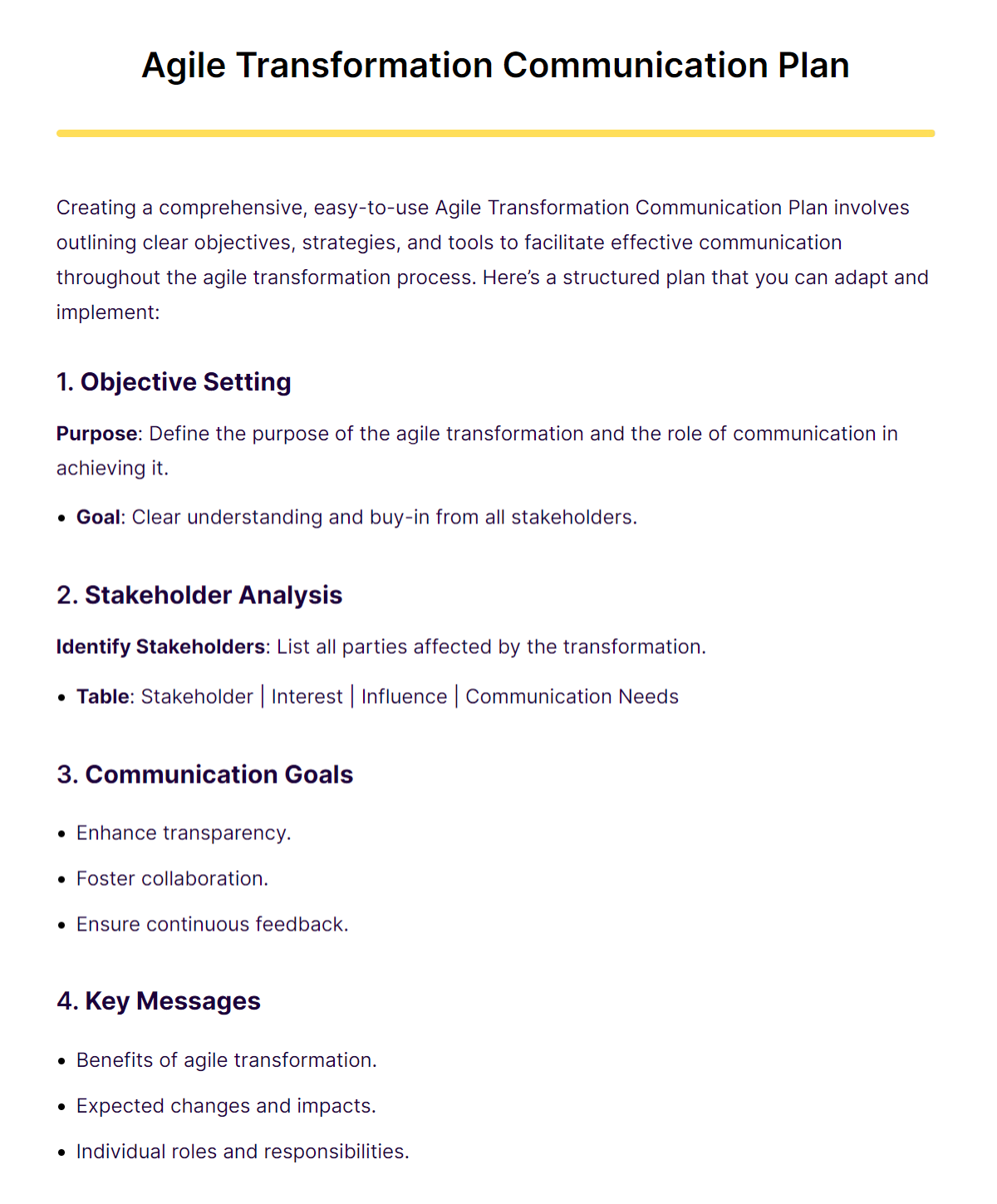
TheAgile Transformation Communication Plan structured blueprint to facilitate effective communication during agile transformations. It covers setting clear objectives, analyzing stakeholders, defining communication goals, and selecting appropriate channels and tools. The plan emphasizes continuous feedback, risk management, and regular reviews for adaptability and effectiveness. Visual tools and detailed schedules support the clear and purposeful communication needed for a smoother transition and improved collaboration
Agile Project Communication Plan
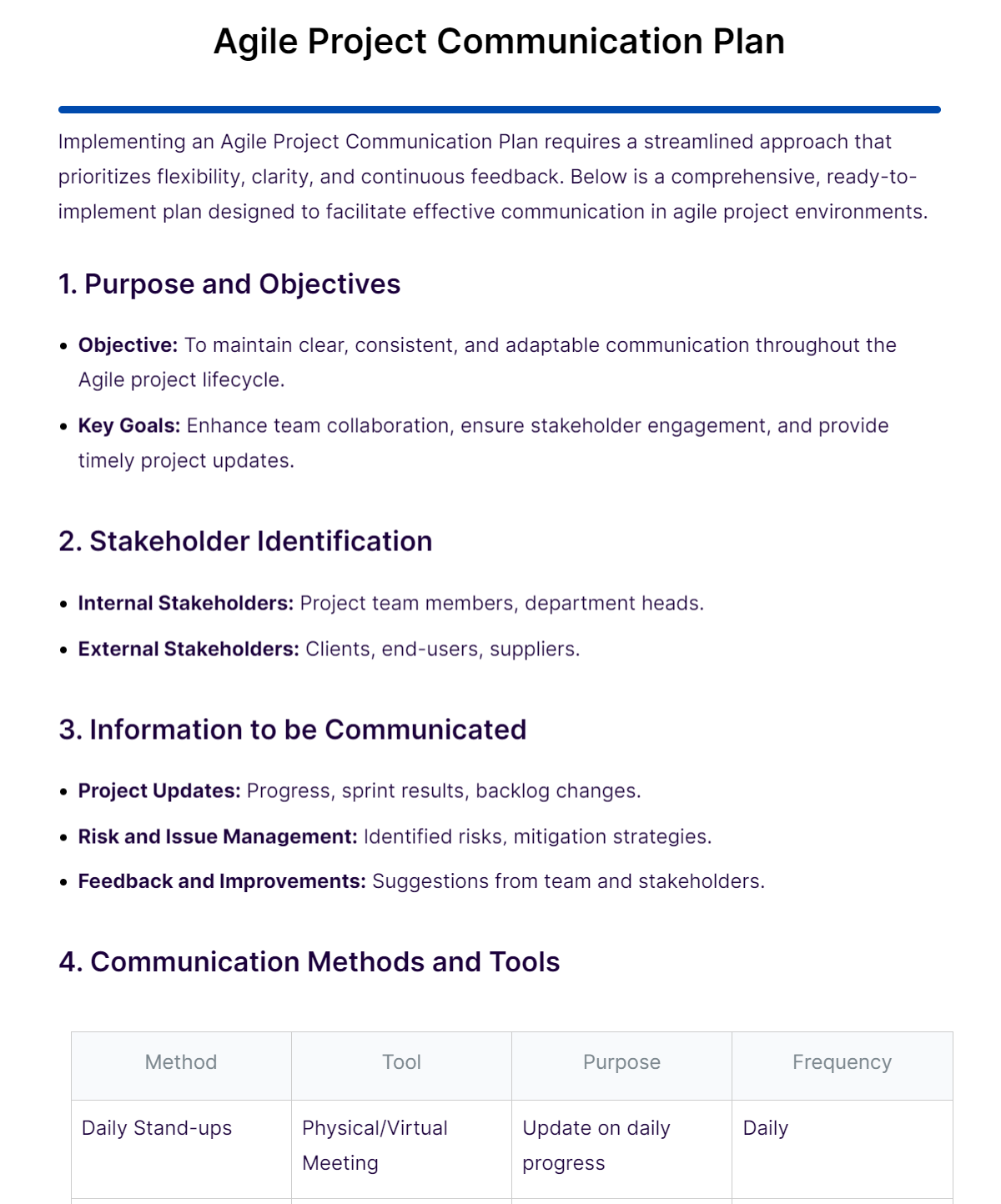
The Agile Project Communication Plan Examples is a streamlined approach to Agile communication, emphasizing flexibility, clarity, and continuous feedback. It provides a comprehensive, ready-to-implement plan tailored for agile project environments, ensuring effective communication throughout a project’s lifecycle. The plan is designed to be simple yet thorough, adaptable to various project needs while adhering to the core principles of Agile methodology.
Agile Communication for Project Management
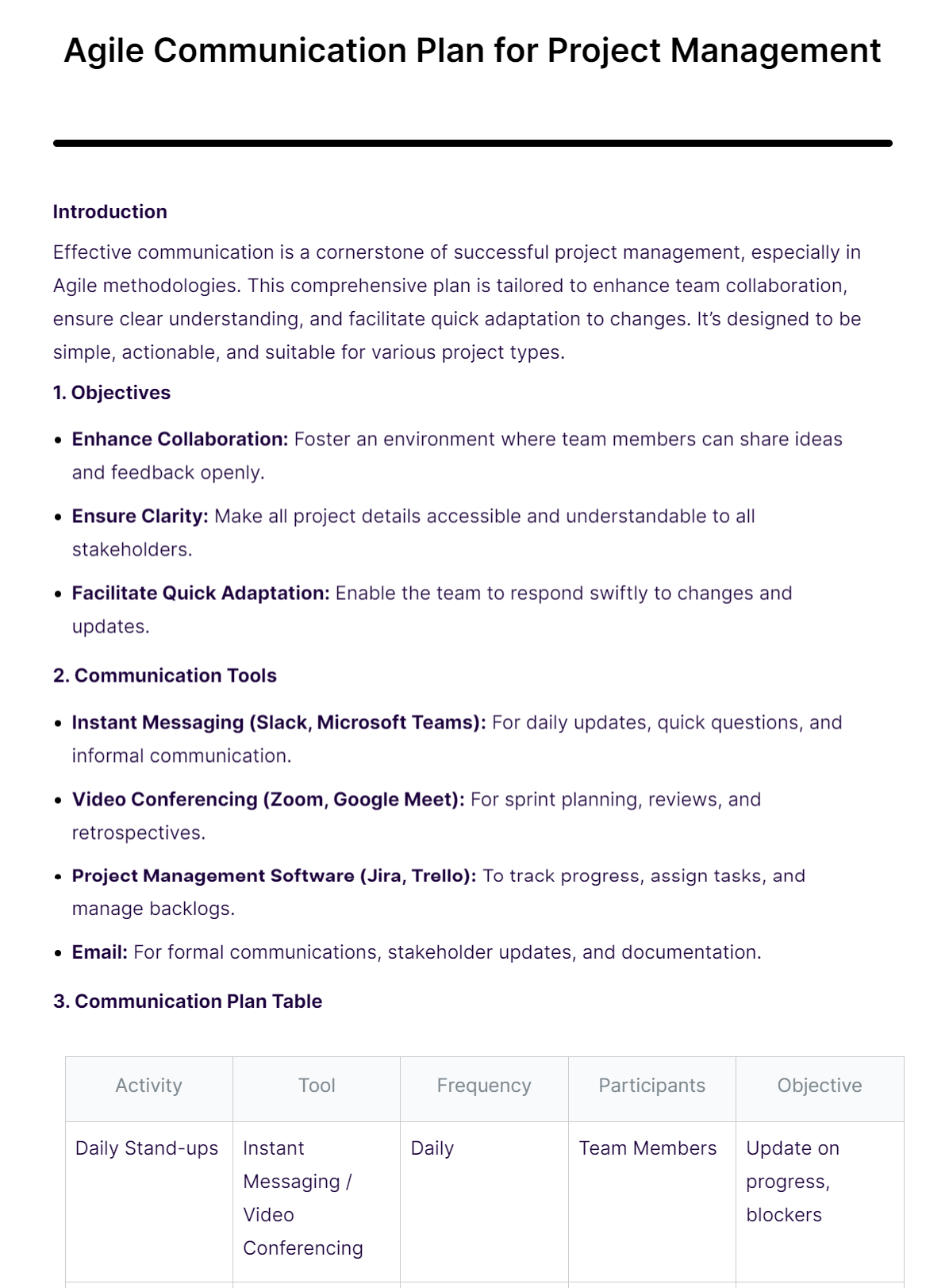
The Agile Communication Plan for Project Management is a detailed guide for enhancing team collaboration and clarity in Agile project environments. It covers objectives like fostering open communication, ensuring clarity, and adapting quickly to changes. The plan outlines various communication tools, including instant messaging, video conferencing, and project management Communication Plan software, and sets a structure for activities like daily stand-ups and sprint planning. Emphasizing key principles such as transparency, adaptability, and respect, the plan aims to create a cohesive, responsive project management environment.
Agile Project Communication Plan Template in Word, Google Docs, PDF, Apple Pages
Agile Project Management Communication Plan Template
Agile Communication Plan Strategy Development
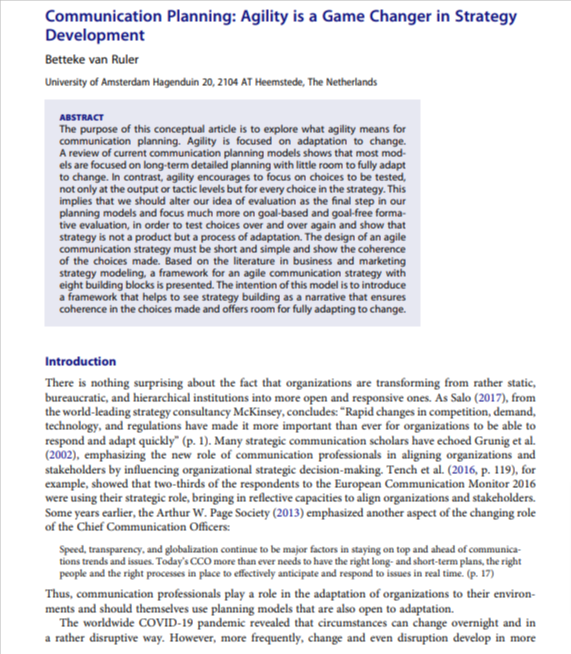
pure.uva.nl
DownloadAgile Team Communication Plan
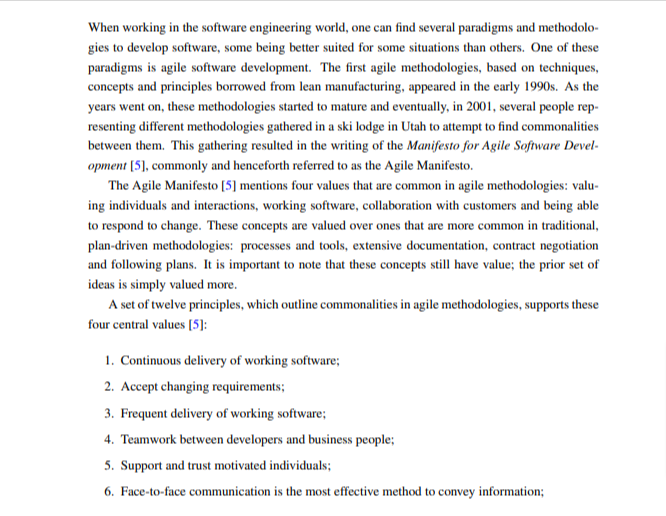
repositorio-aberto.up.pt
DownloadCommunication Plan for Agile Projects
A well-structured Communication Plan for Agile Projects ensures streamlined and effective dialogue within dynamic project environments. This plan focuses on adaptability, transparency, and continuous feedback, crucial for agile project success. It aligns team members towards common goals, facilitating rapid responses to change and fostering a collaborative spirit.
1. Daily Stand-Up Meetings
Explanation: A brief daily meeting where team members report progress and discuss challenges. Example: Today, I completed the UI design and will start on the backend integration.
2. Sprint Planning Sessions
Explanation: These sessions define what will be delivered in the next sprint.
Example: For this sprint, let’s focus on developing the checkout feature.
3. Retrospective Meetings
Explanation: Post-sprint meetings to reflect on the process and improve future sprints.
Example: Let’s discuss what worked well and what can be improved for the next sprint.
4. Kanban Boards
Explanation: Visual tools that track progress and workflow in real-time.
Example: I’ve moved the task ‘Database Optimization’ to the ‘In Progress’ column.
5. Product Backlog Grooming
Explanation: Regular review and prioritization of the product backlog.
Example: Let’s refine the backlog to ensure our priorities align with the client’s needs.
Agile communication planning methods are strategic approaches designed to enhance team interaction and project transparency. They focus on adaptability, continuous feedback, and clear, concise messaging. These methods aim to improve team dynamics, project outcomes, and adaptability to change, aligning closely with Agile Communication Plan principles.
1. Daily Stand-Ups
Explanation: A brief daily meeting where team members discuss their progress, plans, and any impediments.
How to Communicate: “Yesterday, I completed the design module. Today, I’ll start on the coding. I’m facing a challenge with the new software update.”
2. Sprint Planning Meetings
Explanation: A session at the start of each sprint where the team decides on the work to be done.
How to Communicate: “For this sprint, let’s focus on user authentication features. I suggest we divide tasks among frontend and backend teams.”
3. Kanban Boards
Explanation: A visual tool for tracking progress, tasks, and backlogs.
How to Communicate: “I’ve moved the task ‘Design Homepage’ to the ‘Completed’ column. Does anyone need help in the ‘In Progress’ section?”
4. Retrospective Meetings
Explanation: A meeting at the end of each sprint to discuss what went well and what could be improved.
How to Communicate: “I think the new deployment strategy worked well, but we need to improve our testing coverage next time.”
5. User Story Mapping
Explanation: A technique that helps teams understand the user journey and prioritize tasks.
How to Communicate: “Looking at our story map, I believe the ‘Checkout Process’ should be our next priority for development.”
Implementing the best practices for Agile Communication is vital for maintaining a dynamic, responsive, and collaborative environment. This guide outlines the essential strategies and techniques to enhance the effectiveness of communication within an Agile framework, ensuring that your team is aligned, informed, and ready to adapt to changes swiftly.
Embrace Open and Honest Dialogue: Encourage an environment where team members feel comfortable sharing their thoughts, ideas, and concerns. Open and honest communication fosters trust and builds a strong foundation for collaboration.
Implement Regular Stand-Ups: Hold short, daily stand-up meetings to keep everyone updated on progress and obstacles. This routine ensures that each team member is aware of the project’s status and can adjust their work accordingly.
Use Visual Tools for Clarity: Incorporate visual aids like Kanban boards or Scrum boards to provide a clear overview of tasks, progress, and bottlenecks. Visual tools help in simplifying complex information and keeping everyone on the same page.
Prioritize Direct, Face-to-Face Communication: Whenever possible, opt for direct communication to reduce misunderstandings and provide immediate feedback. Face-to-face interactions, whether in-person or via video calls, can significantly enhance the quality of communication.
Foster a Feedback Culture: Encourage regular feedback among team members and from stakeholders. Constructive feedback is a cornerstone of continuous improvement and helps in addressing issues promptly and effectively.
Adapt Communication to the Audience: Tailor your communication style and methods to suit the audience, whether it’s team members, stakeholders, or clients. Understanding your audience ensures that your message is received and understood as intended.
Streamline Information Sharing: Utilize communication tools and platforms that enable efficient information sharing and collaboration. Choose tools that best fit your team’s needs and ensure everyone is trained to use them effectively.
Establish Clear Roles and Responsibilities: Clearly define the roles and responsibilities of each team member, including who is responsible for communicating specific types of information. This clarity prevents overlap and ensures that all necessary information is communicated.
Plan for Regular Reflection and Adjustment: Schedule regular reviews of your communication plan and practices. Reflect on what is working and what isn’t, and be prepared to make adjustments as needed. Agile is all about adapting to change, and your communication practices should reflect this.
Document Key Information: While Agile emphasizes verbal communication, it’s also important to document key decisions, changes, and action items. This documentation ensures that everyone has access to the same information and can refer back to it as needed.
How to Create an Effective Agile Communication Plan?
Creating an effective Agile Communication Plan is crucial for fostering a flexible, responsive, and collaborative environment in any team or organization. This guide will walk you through the steps to design a plan that not only meets the dynamic needs of your team but also promotes a culture of open and efficient communication.
Understand the Basics of Agile Communication: Before diving into the planning process, grasp the core principles of Agile communication. It’s about continuous, transparent, and adaptive interactions that respond swiftly to changes and foster a collaborative team environment. Knowing these fundamentals will help you tailor a plan that truly embodies the agile spirit.
Identify Your Team’s Communication Needs: Every team is unique. Assess the specific communication needs, challenges, and preferences of your team. Consider factors like project scope, team size, and individual roles to determine the frequency, mode, and content of communication required.
Set Clear Communication Goals: Define what you want to achieve with your Agile Communication Plan. Goals might include enhancing collaboration, ensuring everyone is updated on project changes, or improving problem-solving speed. Make these goals SMART: Specific, Measurable, Achievable, Relevant, and Time-bound.
Choose the Right Tools and Techniques: Select communication tools and techniques that align with your team’s needs and goals. This might include daily stand-ups, sprint planning meetings, retrospectives, or digital tools for asynchronous communication. Ensure the tools are accessible and user-friendly to encourage consistent use.
Develop a Flexible Schedule: In agile environments, schedules should be flexible yet structured. Determine the frequency of meetings and updates. Daily stand-ups, weekly progress meetings, and sprint reviews are common in Agile methodologies. However, be ready to adapt the schedule based on project phases and team needs.
Foster an Open Communication Culture: Encourage an environment where team members feel comfortable sharing ideas, challenges, and feedback. Lead by example: be open, listen actively, and respond constructively. An open communication culture is the backbone of an effective Agile Communication Plan.
Monitor, Review, and Adapt: An Agile plan is never set in stone. Regularly monitor its effectiveness and gather feedback from the team. Are the goals being met? Are there any communication bottlenecks? Use this feedback to refine and adapt the plan. Continuous improvement is key to maintaining an effective agile communication strategy.
Document and Share the Plan: Once your plan is in place, document it clearly and share it with the team. Ensure everyone understands their roles and responsibilities within the communication structure. A shared understanding is crucial for the plan’s success.
Creating an Agile Communication Plan requires strategy, adaptability, and a deep understanding of your team’s dynamics. This concise guide offers valuable tips to craft a plan that’s not only effective but also promotes a culture of openness and rapid response. From embracing flexibility to ensuring continuous improvement, these insights will help you build a robust communication framework suited to the agile world.
Daily Stand-Ups: Kick off each day with a brief team meeting.
Let’s quickly share our updates and hurdles today to stay aligned and tackle any challenges promptly.
Sprint Retrospectives: Reflect on the past sprint to improve future ones.
Let’s discuss what went well and what we can improve for a more effective next sprint.
Visual Communication Boards: Use tools like Kanban or Scrum boards for clarity.
Check the board for task progress and updates, and let’s keep it current for real-time transparency.
Feedback Sessions: Regular, constructive feedback loops.
Let’s provide specific feedback to help each other grow and improve our collaborative efforts.
Open Door Policy: Encourage open communication at any time.
Feel free to share your ideas or concerns with me; my door is always open.
Empathetic Listening: Foster an environment where team members feel heard.
I want to understand your perspective fully. Can you tell me more about this?
Asynchronous Updates: Use tools for team members to update at their convenience.
Please update your status on the tool by EOD so we all know where the project stands.
Role Clarification Sessions: Ensure everyone understands their responsibilities.
Let’s clarify our roles to ensure we’re all moving in the right direction together.
Conflict Resolution Meetings: Address and resolve disputes quickly and effectively.
Let’s discuss this issue openly and find a resolution that works for everyone involved.
Continuous Learning Opportunities: Keep the team updated with the latest communication techniques.
There’s a webinar on effective communication next week. It could be great for us to join and learn together.
In agile project management, effective communication is key for team success. Agile teams often employ frequent, structured communications to ensure alignment and efficiency. The use of Work Breakdown Structures (WBS) in this context likely refers to the practice of breaking down projects into smaller, manageable components, facilitating clearer communication and better project tracking. By integrating WBS in agile methodologies, teams can enhance collaboration and adaptability, crucial for agile environments.
Meaningful Client Communication in Agile Projects,” a general summary would likely focus on the importance of effective and clear communication with clients in Agile project management. It would emphasize agile strategies for maintaining open lines of communication, adapting to client needs, and ensuring that project goals and progress are transparent. This approach is crucial in Agile methodology to foster collaboration, manage expectations, and drive successful project outcomes. For more detailed insights, I recommend visiting the original article on UX Planet.



